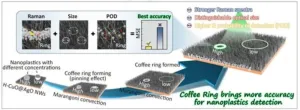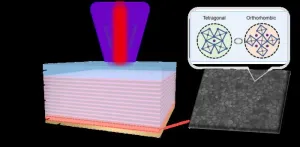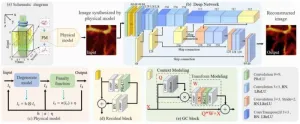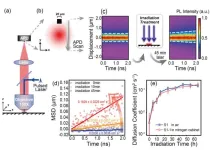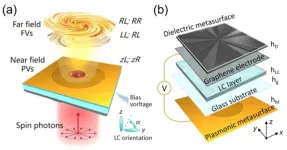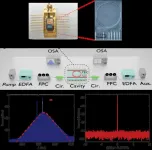(Press-News.org) Decarbonisation in the automotive and housing sectors is paramount if the UK’s legally binding commitment to achieving net zero by 2050 is to succeed, say researchers at University of Sheffield
Exploring the presence of socioeconomic inequalities in the uptake of low-carbon technologies (LCTs), such as solar panels and electric vehicles, has important policy implications for the decarbonisation in the UK
The new report advocates for interventions at an individual, as well as community-level, to help those from more disadvantaged backgrounds adopt technologies that could lower their household bills,
Education, age, occupation, gender and ethnicity are all contributing factors in an individual's ability to adopt LCTs
The UK government needs to go beyond offering subsidies for low-carbon technologies (LCTs) like electric cars and solar panels for energy and heating, if it is to meet its net-zero targets by 2050, a new report from the University of Sheffield suggests.
The report, published with partners from the universities of Nottingham and Macedonia, found that although gains are being made in encouraging people to adopt low-carbon technologies, not enough is being done to continue to reduce the inequalities in uptake amongst some socioeconomic groups.
In recent years households using solar panels for electricity generation has increased from 3 to 6.5 per cent, the adoption of solar panels being used for heating increased from 1.4 to 2.1 per cent and households using an electric or hybrid-electric vehicle increased from less than 1 per cent to 2.8 per cent, reflecting the growing adoption of LCTs nationally.
However, the study found that although socioeconomic inequalities in LCTs adoption have decreased over the past decade, they still persist. Factors such as age, education, occupation, ethnicity and gender all contribute directly and indirectly to people’s ability to invest in LCTs.
The report authors say more needs to be done to level the playing field, and help those from more disadvantaged backgrounds adopt technologies that could lower their household bills, and contribute to the UK’s decarbonisation in the housing and automotive sectors.
Dr Andrew Burlinson, from the University of Sheffield’s School of Economics, said: “Our research suggests that some socioeconomic groups have not been adequately supported to adopt LCTs. So it is important to emphasise that by limiting the ability of the most disadvantaged groups to invest in technology that can lower their bills and increase resilience to fluctuating living costs – such as current high energy prices – may further exacerbate broader inequalities in our society.
“Our analysis reveals that educated and affluent households are more likely to have been able to adopt low-carbon technologies early, such as solar energy, solar heating and electric or hybrid transport.
“Yet some existing financial subsidies to help people transition to LCTs have now ended, so those members of society who were unable to become early-adopters are now being left behind in the transition to net-zero.”
The UK government currently subsidises the purchase of some types of electric vehicles at the point of sale, but these subsidies are largely independent of the socioeconomic status of the consumer. Alongside this, subsidies to install domestic solar panels ended in 2019, which means that incentives to help people adopt LCTs are now limited, and may be working less well for those members of society with a lower socioeconomic status.
The authors say exploring the presence of socioeconomic inequalities in LCTs in the UK has important policy implications for the low-carbon transition, and the achievements of the UK government's ambitious and legally binding environmental targets.
There are positive signs that some consumers are increasingly adopting more sustainable ways to live and travel. But the Climate Change Committee reports that for the UK to make significant gains in reaching its net-zero targets, the market share for new electric vehicles needs to be at 100 per cent, from only 16.5 per cent today, and that solar panel installation rates need to increase by five times that of current levels.
Professor Monica Giulietti, from the University of Nottingham, said: “In our report and new policy brief, we suggest it is vital that new interventions should be targeted towards those groups that could potentially benefit the most from cost-reducing technologies, not just at individual level but at a community level as well. This action will rely on addressing policy gaps in the private, rented and social housing sectors.”
As well as more targeted financial incentives for those of a lower socioeconomic position, the report calls for information incentives provided by trusted organisations to establish educational guidance and increase awareness of LCTs; to help those most in need navigate decision making about adoption.
The report also argues that new interventions need to be made at community level. Rather than advocating for solar technology just for individual households, a shift towards community installations is suggested to help alleviate the cost burden of adoption, and help level the playing field for those who do not have individual control over their property or transport.
Commenting on the research, Dr Jayne Carrick, from the South Yorkshire Sustainability Centre, said: “A recent survey conducted by the South Yorkshire Sustainability Centre into the region’s energy consumption habits revealed a significant hurdle to low-carbon technologies: 46 per cent of residents are reluctant to adopt solar panels, and 57 per cent are hesitant about heat pumps.
“Much more needs to be done in UK policy to address the inequality in uptake and beyond. For example, the opportunity to unlock the power of community energy initiatives is a crucial area, streamlining processes and fostering collective investment to make LCTs accessible for all.”
Dr Andrew Burlinson added: “The findings of the new report add to the growing debate on the low individual uptake of LCTs, and the problems created for consumers from more disadvantaged backgrounds when access to the benefits of low-carbon technologies is unequally distributed.
“Our results lead us to support policies targeting specific socioeconomic groups at individual and community level, which is not only crucial to mitigate the observed inequalities in LCT adoption, but also relevant in promoting energy efficiency and resilience to high energy prices as we transition towards a low-carbon future.”
END
Government urged to tackle inequality in ‘low-carbon tech’ like solar panels and electric cars
2025-04-10
ELSE PRESS RELEASES FROM THIS DATE:
Moffitt-led international study finds new drug delivery system effective against rare eye cancer
2025-04-10
TAMPA, Fla. (Apr. 10, 2025) — A multi-institutional study led by Moffitt Cancer Center found that percutaneous hepatic perfusion using a melphalan hepatic delivery system may help patients with a rare eye cancer that has spread to their liver. This disease, known as metastatic uveal melanoma, is traditionally very hard to treat and usually has poor outcomes.
The phase 3 FOCUS trial, published in the Annals of Surgical Oncology, compared two treatments for metastatic uveal melanoma. One group of patients received the melphalan hepatic delivery system treatment, while the other group received standard of care treatment. Patients treated with the melphalan hepatic delivery ...
Boston stroke neurologist elected new American Academy of Neurology president
2025-04-10
MINNEAPOLIS —The American Academy of Neurology (AAN), the world’s largest association of neurologists and neuroscience professionals, has elected Natalia S. Rost, MD, MPH, FAAN, FAHA, as its 39th president. Rost is professor of neurology at Harvard Medical School in Boston, and the C. Miller Fisher Endowed Chair in Stroke Research and former chief of the stroke division at Massachusetts General Hospital. Rost succeeds Carlayne E. Jackson, MD, FAAN, who completed her two-year term as president during the recent AAN Annual Meeting.
“I applaud Dr. Jackson for her leadership, and I am thrilled to take the helm at the American Academy of Neurology ...
Center for Open Science launches collaborative health research replication initiative
2025-04-10
Charlottesville, VA — The Center for Open Science (COS) has announced the launch of the Replicability Project: Health Behavior (RPHB), a collaborative initiative that aims to strengthen the evidence base and advance scientific integrity in health-related research. The project will examine the replicability of a diverse sample of quantitative health studies published over the past decade (2015–2024).
Assessing the credibility of research is essential to advancing scientific integrity and maintaining public trust in science. The RPHB initiative aims to perform up to 60+ replications of empirical health behavior studies, providing crucial ...
Crystal L. Mackall, MD, FAACR, recognized with the 2025 AACR-Cancer Research Institute Lloyd J. Old Award in Cancer Immunology
2025-04-10
CHICAGO – The American Association for Cancer Research (AACR)-Cancer Research Institute (CRI) Lloyd J. Old Award in Cancer Immunology will be presented to Crystal L. Mackall, MD, Fellow of the AACR Academy, during the AACR Annual Meeting 2025, to be held April 25-30 at the McCormick Place Convention Center in Chicago, Illinois.
Mackall is the Ernest and Amelia Gallo Family Professor and Professor of Pediatrics and Medicine at Stanford University, the founding director of the Stanford Center for Cancer Cell Therapy, and director of the Parker Institute for Cancer Immunotherapy at Stanford. She is being honored for her illustrious contributions to cancer immunotherapy, including ...
A novel strategy for detecting trace-level nanoplastics in aquatic environments: Multi-feature machine learning-enhanced SERS quantification leveraging the coffee ring effect
2025-04-10
A new publication from Opto-Electronic Advances; DOI 10.29026/oea.2025.240260 discusses a novel strategy for detecting trace-level nanoplastics in aquatic environments.
Plastic materials have revolutionized human lifestyles through their versatile applications, yet their environmental legacy now presents critical challenges to global ecosystems and public health. Current models estimate annual plastic influx into aquatic systems at 4.8-12.7 million metric tonnes, with projections suggesting cumulative marine plastic accumulation ...
Blending the old and the new: Phase-change perovskite enable traditional VCSEL to achieve low-threshold, tunable single-mode lasers
2025-04-10
A new publication from Opto-Electronic Advances; DOI 10.29026/oea.2025.240220, discusses how phase-change perovskite enables traditional VCSEL to achieve low-threshold, tunable single-mode lasers.
As an important light source, lasers are widely used in many fields such as communications, medical treatment, display technology and scientific research. However, with the continuous advancement of technology, people have put forward higher requirements on the performance of lasers, especially in terms of integration and tunability. Traditional lasers typically rely on fixed gain media and external microcavity structures (such as Fabry-Perot cavities, ...
Enhanced photoacoustic microscopy with physics-embedded degeneration learning
2025-04-10
A new publication from Opto-Electronic Advances; DOI 10.29026/oea.2025.240189, discusses enhanced photoacoustic microscopy with physics-embedded degeneration learning.
In recent years, photoacoustic imaging (PAI), as an emerging imaging technology, has gradually attracted widespread attention across various fields, particularly in interdisciplinary areas such as medicine, physics, and chemistry. In brief, PAI combines the unique advantages of both optics and acoustics. The fundamental principle of PAI is as follows: when laser light ...
Light boosts exciton transport in organic molecular crystal
2025-04-10
A new publication from Opto-Electronic Advances; 10.29026/oea.2025.240207, discusses how light boosts exciton transport in organic molecular crystal.
Organic semiconductors, composed of organic molecules or polymers, offer advantages such as low cost, flexibility, lightweight design, and tunable structural-functional properties. They have significant applications in OLED displays (e.g., smartphones, TVs), organic photovoltaic cells (flexible solar panels), and flexible sensors. In organic semiconductors, excitons—carriers of excited-state ...
On-chip multi-channel near-far field terahertz vortices with parity breaking and active modulation
2025-04-10
A new publication from Opto-Electronic Advances; DOI 10.29026/oea.2025.240250, discusses on-chip multi-channel near-far field terahertz vortices with parity breaking and active modulation.
Vortex beams with helical phase wavefronts can carry orbital angular momentum (OAM) and have promising applications in high-capacity communication, information processing and high-resolution imaging. With the further development of terahertz (THz) technology in the fields of communication, radar and substance detection, ...
The generation of avoided-mode-crossing soliton microcombs
2025-04-10
A new publication from Opto-Electronic Advances; DOI 10.29026/oea.2025.240257 , discusses generation of avoided-mode-crossing soliton microcombs.
Optical frequency combs refer to spectra composed of a series of frequency components that are uniformly spaced, resembling the teeth of a comb, thus the term "optical frequency comb." In recent years, optical frequency combs generated in microresonators (known as microcombs) have attracted significant attention due to their high repetition rates, broad bandwidths, ...
